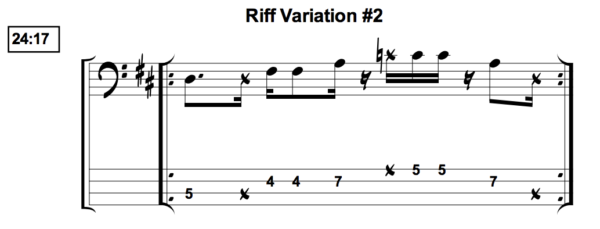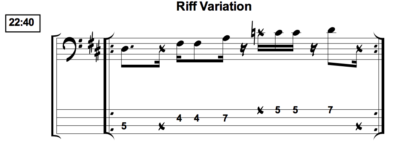This week I’m going to show you how to use the Dominant 7 chord tones and a bass drum pattern to build a cool funky bassline
Starting A Groove
The foundation of any groove is rhythm. Therefore, your first port of call when creating a bass groove is the kick drum pattern. Locking in with the drums will create a solid foundation for the other instruments to build on. Here is the notation for a simple funky drum beat:
Using this pattern, we can come up with our own bass groove that falls on the same beats.
(1) e (+) a 2 e + a 3 e (+) a 4 (e) + a
The bracketed notes are where the kick falls and by copying this pattern, we can come up with our own bass groove that falls on the same beats.
Adding Chord Tones
Now we can add some notes to our groove to spice it up. Below is the notation for a D7 arpeggio – familiarise yourself with this shape until you feel comfortable with the fingering and sound of it.
To make this into a funky bass groove, we are going to apply this arpeggio to the rhythm we used earlier:

This basic groove simply ascends the D7 arpeggio while locking in with the kick drum rhythm. Notice that the notes aren’t held for their full duration as cutting them off short gives the line its funky feel.
Adding Variation
Now you have the basic foundation of a groove, you can start to add in some extra sweeteners to funk it up.
Ghost notes are one way to make your line more funky as they are more percussive and enhance the rhythmic variation. A simple way to include ghost notes in your playing is by putting them in front of the notes in your groove.

Another way we can vary the groove is by changing the notes we use. In the next variation, we are going to return to the 5th (A), instead of ending the groove on D.

We can add this variation to the end of the original riff and use it as a turnaround to return to the beginning:
If we want to make this groove even more funky, we can add in a few extra 16th notes to double up the chord tones:

Notice how this variation still contains the original foundation of the groove we made at the beginning. The trick is to keep the song grooving and not overload it with too many variations – use your original foundation as the main groove and add the extra sweeteners in when it feels right.
The last technique we are going to look at today is changing the octaves of the notes in your groove. This riff contains exactly the same notes as the groove above but it goes below the root instead of above.



















Well done Mark. Brilliantly explained. I really like the way you build from the bass drum pattern. Everything that follows i can understand clearly. Your lessons are excellent. I love this site
Mark, thank you a ton for your kindness in sharing your knowledge with us earthlings – you are indeed so far above many of us, myself in particular. I have learned and will continue to learn from your awesome lessons. In order to show appreciation for such a generous, sharing spirit, I have Donated through PayPal as a thank you. Will probably do so again, as I take advantage of your super lessons and your generosity. Many, many thanks.
I’m pretty sure the pdf notation on page 2 is wrong. It shows a major 7 chord rather than the the dominant 7 you’re describing and playing.
I noticed that too. I started playing it as written and wondered how that could be considered funky. I’m surprised Mark hasn’t fixed this:)
Mark, I’m actually addicted to your lessons. I’ve been playing bass for so many years, learning by myself through my own experiences in several bands, and basing myself on my musical knowledge from my first studies in classical piano. I use your lessons to confirm what I know and what I do correctly, and to eliminate some wrong habits in bass playing, especially in slapping style. My greatest weakness : ability to improvise and providing cool grooves on the spot. I definitely need to fill my “groove pool” and become free from the playlist I know. The best example : just this cute groove that you did at 6:02, just out of nowhere… I’d like to get the PDF of this one… I need more of these… And how could I become more intuitive in that way ?? Thanks for this high quality training web site. I really appreciate your straight forward teaching style.
Thanks Mark! What a great lesson!
Excellent – thank you Mark. How do I find my way to the next lesson in this series – using scale notes and chromatics? Not quite got my head round the progression of lesson material – sorry!
Mark, I am a self taught bass player that has a great ear. I play gospel music. I struggle some at hearing some bass lines, but your lessons are bringing understanding to what I am hearing and playing on the bass.
Thanks
Thank you very much!! Such a great lesson!
Love these lessons. Making it fun and keeping interested! I’m going to get it sooner or later
Mark where is the drum groove
Wow. This blew my mind. The brilliance of this particular video was how a complicated beat count unleashed a wave of creativity through arpeggios , ghost notes et al within a funky context. I personally struggle at times to unleash chords and arpeggios etc creatively. By counting and concentrating on the drum beat first I all of a sudden found inspiration to apply a myriad of tonal possibilities within that key. This probably sounds confusing but I know what I am getting at. Lol. Thank you Mark.
`Thank you Mark for this Funky Line, super cool.
I was learning the Notes Lessons for an hour plus.
Then decided to try this funky sound . Was my reward after going through the Notes Lessons 1/3 and 2/3
Thanks a lot
the drum track would be nice so we could practice